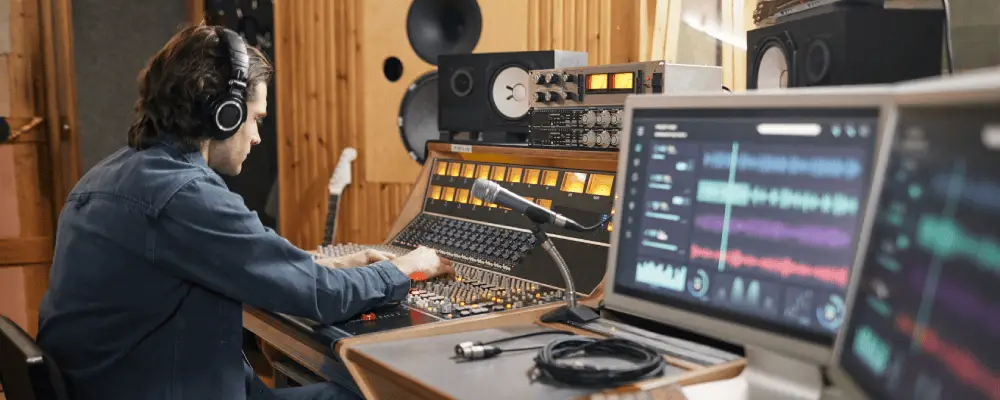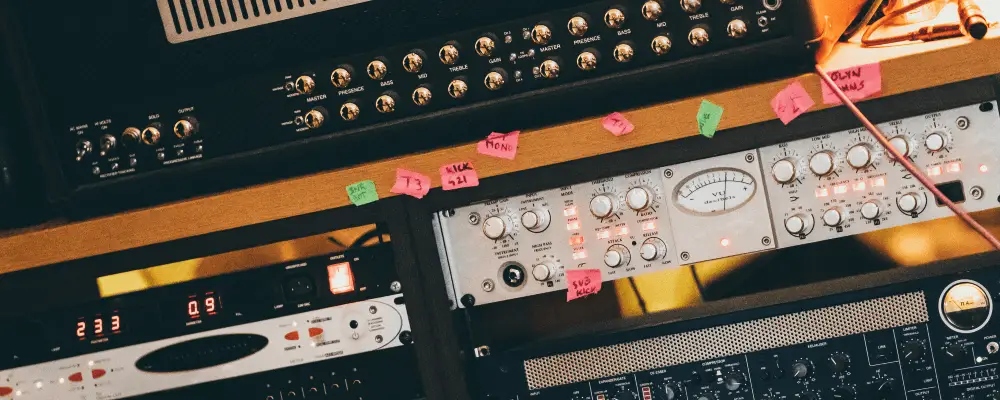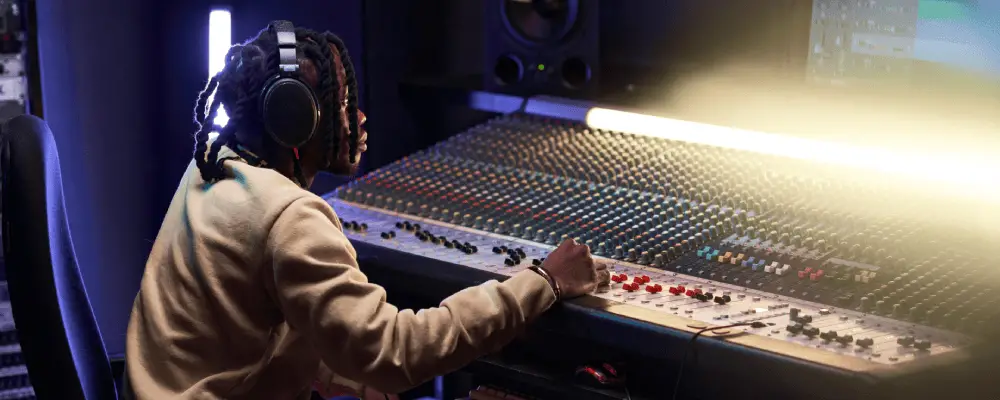In the realm of music production, there are two fundamental processes that play a pivotal role in shaping the final sound of a recording: mixing and mastering. These processes are often mentioned in discussions about professional-quality music, but what exactly do they entail, and how do they differ from each other?
Mixing and mastering are two distinct stages in the music production process, each with its specific objectives. Mixing focuses on the balance, placement, and processing of the individual layers of a song, while mastering refines the already mixed track, ensuring sonic consistency, clarity, and optimal playback across various platforms.
Understanding the distinctions between mixing and mastering is essential for aspiring producers and musicians who want to take their craft to the next level. Whether you’re just starting your music production journey or looking to expand your knowledge, this article will guide you through the differences between mixing and mastering and shed light on their respective roles.
Without further ado, let’s get started!

What Is Mixing?
Mixing is the art of combining individual tracks, such as vocals, instruments, and effects, into a cohesive and balanced stereo mix. It is the stage where the raw recorded elements are molded, shaped, and brought together to create a unified sonic experience.
A mix engineer takes on the responsibility of balancing the levels of each track, adjusting the panning (placement of sounds in the stereo field), and applying equalization (EQ) to enhance or correct the frequency balance. They also work with effects such as reverb, delay, and compression to add depth, ambiance, and dynamics to the mix.
The primary objective of mixing is to achieve a well-balanced, clear, and impactful sound where each element of the track contributes harmoniously. It involves making creative decisions, bringing out the best qualities of each individual track, and ensuring that they work together cohesively.

What Is Mastering?
Mastering is the final stage of music production, where the already mixed track is refined and optimized for distribution across various playback systems and formats. A mastering engineer fine-tunes the mix to ensure it translates well across different listening environments while maintaining the artistic vision of the music.
During mastering, the engineer works on the stereo mix as a whole, making subtle adjustments to achieve sonic consistency, enhance overall clarity, and optimize the track for different mediums. This includes applying EQ, compression, and other processing techniques to address any minor imperfections, control dynamics, and bring out the best sonic qualities.
One of the crucial aspects of mastering is achieving a consistent sound across an entire album or EP, ensuring that all the tracks fit together cohesively. Additionally, mastering involves optimizing the loudness of the track to make it competitive in the context of commercial releases without sacrificing dynamic range or causing distortion.

Key Differences Between Mixing & Mastering
When it comes to music production, understanding the distinctions between mixing and mastering is crucial. While both processes are essential for achieving a polished and professional sound, they serve distinct purposes and require different approaches. Let’s delve into the key differences between mixing and mastering:
Focus & Objectives:
Mixing is primarily concerned with the individual tracks of a song. It involves balancing the various elements, such as vocals, instruments, and effects, to create a cohesive and sonically pleasing mix. The main objectives of mixing include achieving clarity, depth, and separation, while ensuring each element occupies the appropriate sonic space.
On the other hand, mastering takes a broader perspective, focusing on the entire album or collection of songs. The primary goal of mastering is to make the tracks sound consistent and coherent, both in terms of tonal balance and loudness. Mastering engineers use specialized tools and techniques to enhance the overall sonic quality, improve the dynamics, and ensure the tracks translate well across different playback systems.
Timeline:
Mixing typically occurs during the earlier stages of the production process. Once the individual tracks are recorded and edited, the mixing engineer steps in to shape and refine the sound. The mixing process involves adjusting levels, applying EQ and dynamics processing, and adding effects to enhance the sonic characteristics of each track. It’s important to note that a well-mixed track forms the foundation for successful mastering.
Mastering, on the other hand, takes place after the mixing stage is complete. Once all the tracks are mixed and finalized, they are compiled into a cohesive album or EP. The mastering engineer then focuses on the overall balance, consistency, and cohesiveness of the collection. They apply global processing, fine-tune the tonal balance, and prepare the tracks for distribution across various platforms.
Tools & Techniques:
Mixing and mastering employ different sets of tools and techniques to achieve their respective goals. Mixing engineers rely on digital audio workstations (DAWs) and a wide range of plugins to shape individual tracks. EQ plugins help to adjust the frequency balance, while compressors and limiters control dynamics and ensure a more controlled sound. Other tools, such as reverbs, delays, and modulation effects, are used to add depth and create spatial effects.
In contrast, mastering engineers employ specialized mastering software and hardware processors. Multiband compressors, stereo wideners, and harmonic exciters are often used to enhance the overall sound. Additionally, mastering engineers focus on precise level matching, stereo imaging, and applying subtle processing to achieve a cohesive sound across the entire album.
Skillset & Expertise:
Both mixing and mastering require a distinct skillset and expertise. Mixing engineers need to have a keen ear for detail, a deep understanding of audio processing, and strong technical skills. They must be proficient in using EQ, compression, and other tools to achieve a balanced and impactful mix. Moreover, effective communication and collaboration skills are essential when working with artists and producers to bring their vision to life.
Mastering engineers, on the other hand, need a different set of skills. They must possess a critical listening ability, an understanding of psychoacoustics, and extensive knowledge of various playback systems. Their expertise lies in fine-tuning the overall sound, making sonic decisions that enhance the listening experience, and preparing tracks for distribution while adhering to technical standards.

The Mixing Process
Balancing
Balancing is a fundamental aspect of mixing. It involves adjusting the volume levels of each track to achieve a harmonious blend. The mix engineer carefully listens to each element and makes decisions about their relative loudness to ensure clarity and coherence. Balancing allows different instruments and vocals to coexist without overpowering or getting lost in the mix.
Equalization (EQ)
In addition to adjusting levels, mix engineers employ equalization (EQ) to shape the frequency content of each track. EQ helps enhance or correct the tonal balance of individual elements, making them sit better together in the mix. By selectively boosting or cutting certain frequencies, the mix engineer can shape the character of each track.
Creating A Stereo Image
Creating a stereo image is an essential aspect of mixing. It involves placing sounds in the stereo field to create a sense of width and depth. By manipulating the panning of individual tracks, the mix engineer can position instruments or vocals at different locations across the stereo spectrum. This technique contributes to a more immersive and engaging listening experience.
To enhance the stereo image further, mix engineers can utilize stereo imaging plugins and techniques. These tools allow for precise control over the perceived width and depth of the mix. By widening or narrowing the stereo field, they can add a sense of spaciousness or focus to specific elements.
Applying Effects & Processing
Effects and processing play a crucial role in the mixing process. They add character, depth, and dynamics to the mix, enhancing the overall sound and creating a unique sonic signature. Common effects used in mixing include reverb, delay, compression, and modulation.
Reverb and delay add a sense of space and ambiance to the mix. They can make a track sound as if it’s in a large hall or create a sense of depth by simulating reflections. Compression helps control the dynamic range of individual tracks, ensuring that quieter parts are audible and louder sections don’t overpower the mix.
Furthermore, mix engineers use EQ, compression, and other processing tools creatively to shape the sound and add unique sonic elements. These effects are applied to individual tracks or the overall mix, bringing out desired characteristics and achieving a polished and professional sound.

The Mastering Process
Enhancing The Mix
During mastering, the engineer addresses any minor imperfections or sonic issues that may have been missed during the mixing stage. They use a combination of EQ, compression, and other processing techniques to refine the mix and ensure it sounds as good as possible.
EQ adjustments in mastering are often broader and more subtle compared to mixing. The mastering engineer may make slight tweaks to the overall tonal balance, focusing on enhancing the clarity, warmth, or brightness of the mix. This helps to correct any frequency imbalances and achieve a more polished sound.
Compression and dynamic processing in mastering are used to control the overall dynamics of the mix and ensure consistency throughout the track. This involves applying subtle compression to even out volume fluctuations, enhance sustain, and create a more controlled and cohesive sound.
Achieving Consistency & Loudness
Another crucial aspect of mastering is achieving consistency in levels and frequencies across different tracks within an album or EP. The mastering engineer ensures that all the songs fit together cohesively, with consistent tonal balance and volume levels. This helps create a unified listening experience for the audience.
Moreover, mastering involves optimizing the loudness of the track for commercial release. The goal is to achieve a competitive loudness level while maintaining the dynamic range and avoiding excessive distortion or artifacts. This ensures that the track stands up to other commercially released music in terms of perceived volume.
Preparing For Distribution
Preparing the mastered audio for distribution is an essential part of the mastering process. Different distribution platforms and formats may have specific technical requirements and standards. The mastering engineer ensures that the audio is properly formatted, encoded, and ready for delivery on various mediums such as CD, streaming platforms, or vinyl.
By meticulously fine-tuning the mix, addressing imperfections, achieving tonal balance, optimizing loudness, and preparing the audio for distribution, mastering adds the final touches to the music production process. It ensures that the tracks are ready to be enjoyed by listeners in any context or medium.

Conclusion
Understanding the differences between mixing and mastering is vital for anyone involved in music production. Mixing focuses on balancing individual tracks, shaping the sound, and creating a cohesive mix, while mastering addresses the overall sonic characteristics, optimizes the mix, and prepares it for distribution.
By grasping the intricacies of both processes, you can make informed decisions and effectively communicate your artistic vision to the mix engineer and mastering engineer. Collaborating with a separate mastering engineer brings objectivity and expertise to the final stage, ensuring that your music reaches its full potential.
Remember, both mixing and mastering are essential steps in delivering professional-quality music. By investing time and effort into honing your skills in both areas, you’ll be able to create captivating, well-balanced, and polished tracks that leave a lasting impression on your audience.
Related Posts:
13 Tips To Help You Make Better Music
Best Music Production Software In 2023
7 Things To Do Before You Release A Song
Want To Know More?
Here at Live Aspects, we have dozens of useful lessons and tutorials created to enhance your music production skills and help speed up the learning process. You can access our huge range of music theory lessons and production tips and tricks here.